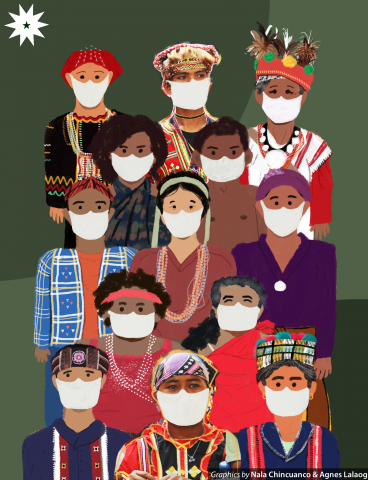
For indigenous peoples across all borders, the struggle for autonomy is an undeniably familiar narrative that spans generations. Subjected to violence, pillaging, and erasure since the Spaniards first stepped on our shores, these communities are consistently relegated to the fringes of history—constantly left behind by the state-constructed Filipino identity characterized by settler colonial symbols.
But their marginalization is not a thing of the past; even now, indigenous communities throughout the country are being displaced. With projects such as the Kaliwa Dam proposed in 2012 and the controversial passing of the Anti-Terrorism Act earlier this year, new chapters of this story are still being written. Now, as society comes to grips with a global pandemic, these communities are forced to the front lines of these injustices and to the sidelines of the collective consciousness.
Under threat
For communities that have long been deprived of essentials such as food and supplies, the lockdown has not only restricted them but also cut off much-needed access to healthcare services and protective equipment. “Indigenous peoples need food supply from the government, non-governmental organizations, and other ally institutions. But when food reliefs [were] stopped, they were forced to intensify their farming activities,” says Maria Easterluna Canoy, the executive director of the Kitanglad Integrated NGOs, Inc. (KIN), which advocates for indigenous people’s rights in protected areas in Northern Mindanao.
Similarly, Lumad communities in Surigao Del Sur doubled their sustainable food production through their community farms. Chad Booc, advocacy officer and a volunteer teacher for Lumad school Alcadev Incorporated, shares that the members worked together to come up with a community response to the pandemic. “They implemented their own lockdown or safety protocols, and they [set up] medical checkpoints,” he shares.
However, things took a turn for the worse in June, when soldiers came to their community. Aside from being put at risk of infection, the abuse and intimidation the Lumad people have long suffered under the hands of state and paramilitary groups only intensified amid the lockdown. The soldiers instituted a curfew, barring the Lumads from going to their own community farms or buying food in the lowlands. Only a month later, 37 Lumad families in Lianga, Surigao Del Sur fled after they were bombed eight times. Soon after, community leaders were threatened with arrests.
Mine eyes have seen
To live with soldiers so close to their homes is to live every second with fear. “You do not know what comes next; you do not know what might happen in the evening or in the next morning,” says Booc. He shares that just this November, soldiers fired at a house where Lumad people were seeking refuge.
Other indigenous groups in the country also face the same attacks. The National Chairperson for Katribu Youth National, Gabriel Torrecampo, states that aside from the forced occupation of Lumad communities, Aeta ancestral lands in Central Luzon were also bombed. “The President himself threatened to bomb the Lumad schools and communities; this is already enough for us to say that as long as he is in power, the attacks will continue and will eventually worsen even more,” he asserts.
On August 31, four Aeta farmers from Lumibao, Zambales were accused of being National People’s Army members and were arrested by soldiers from the 7th Infantry Division. In detainment, they were reportedly forced to eat human feces. Two of these farmers are now charged with violation of the Anti-Terrorism Act of 2020.
Location: stolen land
The lockdown has also magnified the fight against land grabbing, as the consequences of COVID-19 put pressure on the economy. “[There is] a sense of urgency from Duterte to give out these lands to foreign mining companies since [there is] a lot of foreign debt,” explains Booc. Canoy highlights this dilemma, reiterating how much of the ancestral domains of these communities “[are] used for gaining economic benefits.”
The environmental consequences of these pursuits only add more to the growing list of struggles faced by indigenous communities. As corporations continue to destroy natural land, the more vulnerable the country becomes to the effects of climate change. “One of the strongest defenses that we have are the mountains and the forests that these indigenous peoples have been protecting for centuries,” Booc says. As these natural defenses dwindle, indigenous communities are left vulnerable to the devastating impacts of frequent typhoons.
Booc underscores that these activities debilitate the country. “It’s a matter of life and death—not just for them, who are being killed just for defending their lands, but also for us, living in the same country where our kababayans get killed because of these strong typhoons.”
Strength in numbers
From then until now, indigenous people have been at the forefront of resistance movements, waging their battles in the mountains and marching on the streets. They have never ceased to speak up about their struggles for freedom in spite of violence and intimidation.
“We have to go out from our comfort zones,” Booc exerts. “We have to go out from social media, and go out into the streets and organize and rally more people to stand with the poor, stand with the marginalized, stand with the indigenous people.” It is this unified solidarity that may set the stage for a brighter future, for the communities themselves, and for the nation they have so nobly protected throughout history.
Their fight for survival has not been an easy one, nor is it anything new, as many of these systemic injustices have spanned generations. As Torrecampo puts it, ”the struggle of the Igorots, Dumagats, Aetas, Mangyans, Tumanduks, Lumads, and Moros of the country is a shared history, a shared struggle for their rights to their ancestral lands and their right to self-determination.”
